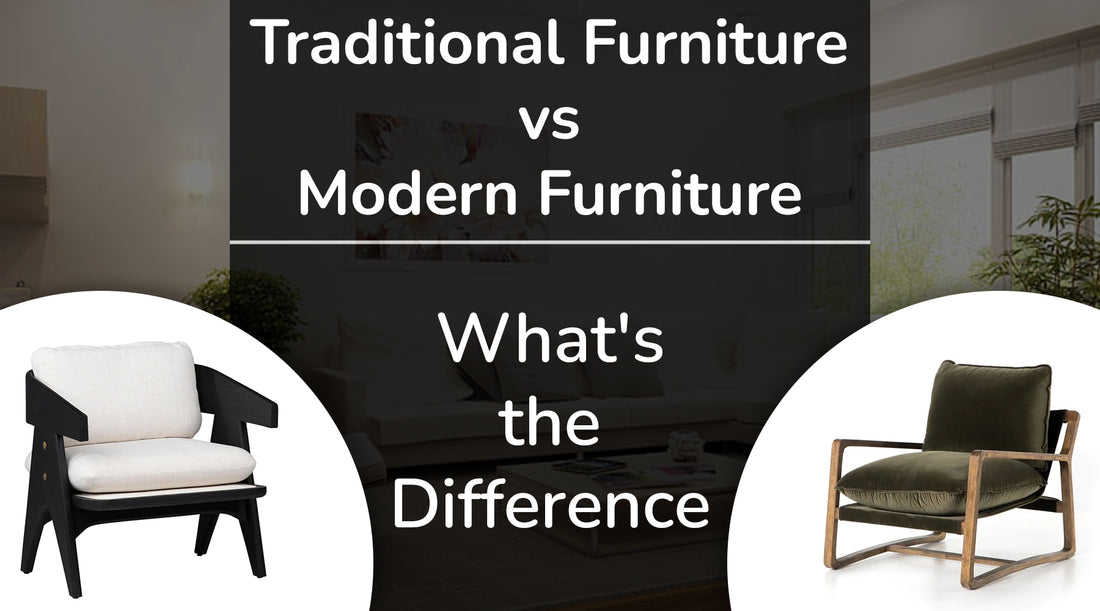When you hear the phrase "traditional furniture," certain images likely come to your mind - a retro setup with wooden couches, rustic and vintage coffee tables, bookshelves in the corners, warm or dim lighting, evoking a Jane Austen aesthetic.

In contrast, "modern furniture" probably conjures posh looking yet minimalist couches, sofas or chairs, cozy coffee tables, and well-lit backgrounds.
Can these stereotypes truly capture the only differences between traditional and modern furniture styles? How exactly do we define or categorize pieces as traditional versus modern? Moreover, if you hope to decorate your home or office with a traditional or modern flair, how do you accomplish that goal?
There are certain key parameters one can learn about to grasp the basic distinctions between traditional and modern furniture.
The purpose of this blog is to break down those differences in the simplest terms. We will also explain how you can thoughtfully design your spaces with a comprehensive understanding of these concepts. By clearly outlining what sets traditional and modern styles apart, readers can then design interiors aligned with their favored aesthetic. Whether a nod to heritage or a showcase of what's new and next.
Everything You Should Know About Traditional Furniture
Traditional style furniture finds its roots in 18th and 19th century European decorative styles, drawing inspiration from ornate furnishings seen in royal palaces and stately homes.
Also Read: 12 Tips for Furnishing and Decorating Small Spaces
Some key features of traditional furniture include:
Colors: Traditional furniture uses subtle, muted color palettes like cream, light brown, ivory, soft rose, sage green and powder blue. These calm, soothing shades evoke heritage and sophistication.
Backgrounds: Traditional room backgrounds showcase architectural details like crown molding, wainscoting panels, and offset lighting from sconces or chandeliers. Floral wallpaper, whitewashed brick, or neutral grasscloth work well.
Upholstery: Tufted leather or linen along with classic patterns like houndstooth and damask are common in traditional furniture. Button tufts, wingbacks, skirted bottoms, and rolled arms also frequent traditional pieces.
Woods: Rich mahogany, walnut, cherry, and oak suit the classic warmth of traditional styles. Intricate wood carvings and finishes like distressing or glazing bring depth.
Decorating: Incorporating antiques, oil paintings in ornate frames, porcelain vases, clawfoot furniture, and Persian area rugs lends traditional refinement. Add ceiling medallions, roman shades, and oblong coffee tables to finish the look.
What are the Pros and Cons of Traditional Furniture?
While beautiful and meaningful, traditional furniture has it’s own set of pros and cons.
The Pros of Traditional Furniture
- Despite decades of evolution, traditional furniture designs remain relevant even today. And when pieces are passed down, they become heirlooms.
- Traditional furniture is made from solid wood by skilled artisans usually using quality joinery and carpentry.
- Traditional furniture evokes a sense of comfort, warmth and nostalgia for the past. These can leave a homey and inviting feeling.
- A handmade solid wood antique in good condition holds a high value in the market and is a good investment.
The Cons of Traditional Furniture
- Furniture made from quality wood is expensive, as are antiques that need to be restored. Some find it too expensive.
- Traditional wood furniture tends to be heavier and take up more visual space which can limit flexibility.
- Not everyone will appreciate traditional furniture. Ornate traditional decor doesn't suit every lifestyle or taste, especially if you are a casual minimalist.
- Traditional furniture should be maintained well. Antique or detailed furniture requires specialized care like polishing, handling delicacy and wood conditioning.
Everything You Need to Know About Modern Furniture
Modern style furniture finds its roots in early 20th-century design movements that embraced new mass production capabilities and rejected overly ornate Victorian and Edwardian decor trends.
Pioneering modern designers sought to create streamlined, lightweight furnishings using new industrial materials like bent steel, chrome, molded plastics and sling fabrics.
Notable influences include the angular geometrics and efficiency championed by the German Bauhaus School, Scandinavian designers’ flair for wood and organic curves, as well as the sleek modular components created in Italy by post-WW2 manufacturers.
Some Key Features of Modern Furniture
Colors: Modern furniture tends to use neutral tones like white, black, gray, tan, or wood shades. These simple hues keep the focus on clean lines instead of color.
Backgrounds: Modern room backgrounds highlight sleekness with plain walls, concrete, glass, metal accents, and bright open spaces.
Upholstery: Common modern upholstery includes leather, microfiber, molded plastic and steel frame sling fabrics. You'll see tailored tufting or no tufting rather than frilly details.
Woods: Modern furniture embraces lighter maple, acacia and ash wood tones. The grains and textures take the spotlight instead of heavy ornate carvings.
Decor: Large abstract art pieces, glass vases, sculptural bookends, and simple patterned rugs maintain an airy, uncluttered look. The goal is minimum embellishments.
As a result, modern styles simplify furniture to its simplest, most functional components. By removing anything excess and highlighting advanced materials, the forward-focused designs feel fresh.
What are the pros and cons of Modern Furniture?
Furniture from the modern era is known for its sleek appearances and compact design, but at the same time modern furniture lacks embellishments, natural materials, or custom adjustability when compared to furniture built traditional. Below is an indepth analysis of modern furniture.
The Pros of Modern Furniture:
- Modern furniture is sleek and stylish highlighting clean lines and shapes that beautifully decorate rooms with an updated aesthetic.
- Modern furniture tends to use high-quality durable materials like molded plastics, chrome and steel metals for long-lasting pieces across decades.
- Modern furniture has compact, space-saving builds maximizing smaller apartments or multi-use rooms.
- Modern furniture is created by skilled designers collaborating with expert manufacturers which ensures quality construction.
- Modern furniture is often more affordable due to mass production streamlining the assembly process.
The Cons of Modern Furniture:
- Modern furniture lacks ornate details or woodwork which some view as soulless or boring after extended daily use.
- Modern furniture primarily uses man-made construction materials instead of natural woods which may bother environmentalists.
- Modern furniture's avant-garde appearances won't suit those wanting conventional or antique styling in their living spaces.
- Modern furniture's stripped-down approach centers on basic utility which fails to accommodate customized needs as readily. Form over function.
Creating Chic Spaces with Traditional and Modern Furniture
When designing rooms, you don't have to choose between just traditional or just modern furniture. Instead, you can get creative mixing pieces from both styles. Here are some ideas that you can use inorder to design your spaces.
Use Modern Furniture in High-Traffic Zones
Modern furniture alternatives work well in high-traffic areas of a home. Slim and durable pieces such as metal or plastic modern furnishings better withstand the all-day activities in spaces like entryways, kitchens, and kids’ rooms. Lightweight modern chairs and glossy white tables readily handle messes and future rearrangements in commonly used zones.
Use Traditional Furniture in Cozy Corners
For cozy and intimate home areas like reading nooks, dining rooms, or private master suites, traditional furniture could highlight decorative architectural details such as crown molding or herringbone-style wood floors most attractively.
The ornate and storied heritage embodied through substantial wood frames and leather upholstery can encourage mental relaxation and a comforting ambiance when decorating recreation-centered spaces.
Soft lighting from classic chandeliers alongside treasured hand-me-down antique elements passed through generations also smoothly carries through the traditional perspective for unwinding and nourishing the soul.
Fusion DecorA furniture fusion idea that blends old and new beautifully is an earthy recycled barnwood TV stand placed right under wall-mounted flatscreen televisions. This combines natural rugged wood tones with sleek technology. Or make a bold colorful statement by putting a bright orange modern couch against old red bricks exposed on a wall background. The mix of vivid new hues and aged wall textures makes fun spaces.
You can also hang modern geometric art prints next to traditional oval oil paintings of nature scenes on the same wall. Mismatched art like this makes things feel more unique and personalized.
Mixing modern and traditional furniture together makes room designs feel more energetic, usable for more purposes, and full of one-of-a-kind promise.
Ultimately any furniture works together if the overall footprint fits the room dimensions and everyone who uses the space feels happy and comfortable.
Also Read: How To Blend Vintage and Modern Decor Items Perfectly?
Conclusion
In conclusion, combining traditional and modern designs is about more than simply aesthetics, it is about accepting the past and looking to the future at the same time. It serves as a reminder that much like our lives, our homes are exquisite tapestries made from both traditional and new materials. Therefore, in order to create a room that is uniquely you, mix and match these styles to incorporate both modern and cozy elements. You need to remember that, in the end, the most comfortable pieces of furniture are the ones that bring you joy.

